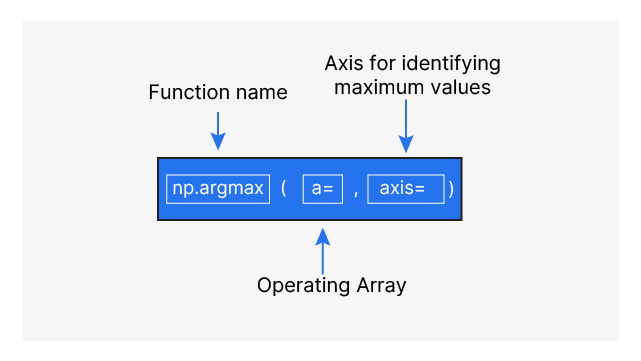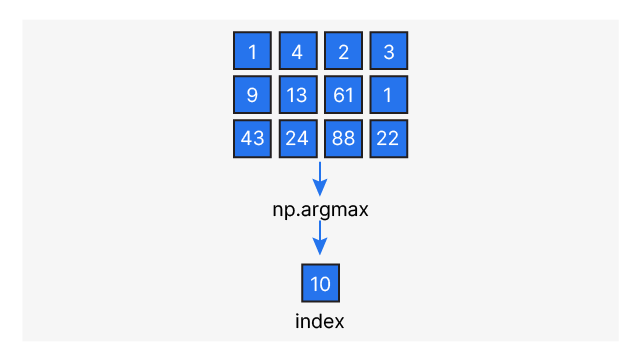Introduction
NumPy is a powerful library for numerical operations in Python, providing support for large, multi-dimensional arrays and matrices. One of the many useful functions in NumPy is the argmax() function, which emerges as a gem, offering a dynamic solution to pinpoint the indices of maximum values along a designated axis within an array. This article delves into NumPy’s argmax() depths, unraveling its syntax, parameters, return values, and practical use cases.

Table of contents
- Understanding NumPy’s argmax() Function
- The Basics of argmax in Python
- Exploring the np.argmax() Function in Python
- Working with NumPy’s argmax() Function
- Practical Examples and Use Cases
- Tips and Tricks for Using argmax in Python
- Comparison with Other NumPy Functions
- Common Errors and Troubleshooting
Understanding NumPy’s argmax() Function
At its core, the argmax() function in NumPy returns the indices of the maximum values along a specified axis in an array. It allows us to efficiently find the position of the maximum element in an array, which can be useful in various scenarios. Examples include finding the most frequent element, identifying the dominant color in an image, or selecting the best model in machine learning.
The Basics of argmax in Python
Before diving into the details of the np.argmax() function, let’s first understand the basics of argmax in Python. The argmax() function is a built-in function in Python that returns the maximum value index in an iterable. It can be used with lists, tuples, or other iterable objects. However, when working with arrays and matrices, NumPy’s argmax() function provides a more efficient and convenient solution.
Exploring the np.argmax() Function in Python
Overview of np.argmax()
The np.argmax() function in NumPy is a part of the numpy module and is used to find the indices of the maximum values along a specified axis in an array. It takes an array as input and returns an array of indices corresponding to the maximum values along the specified axis.
Syntax and Parameters
The syntax of the np.argmax() function is as follows:
numpy.argmax(a, axis=None, out=None)Here, arr is the input array for which we want to find the indices of the maximum values. The axis parameter specifies the axis along which the maximum values are to be determined. If not provided, the function will consider the flattened array. The out parameter allows us to specify an alternate output array to place the result.
Return Value and Usage
The np.argmax() function returns an array of indices corresponding to the maximum values along the specified axis. If the input array has multiple dimensions, the function will return a tuple of arrays, each representing the indices along a particular axis.

Working with NumPy’s argmax() Function
Finding the Maximum Value in an Array
Using NumPy’s argmax() function, we can simply pass the array as the input and omit the axis parameter to find the maximum value in an array. The function will return the maximum value index in the flattened array.
Example:
Code:
import numpy as np
arr = np.array([5, 2, 9, 1, 7])
max_value_index = np.argmax(arr)
print("Maximum value:", arr[max_value_index])Output:
Maximum value: 9

Finding the Index of the Maximum Value
To find the maximum value index along a specific axis in a multi-dimensional array, we can specify the axis parameter in the np.argmax() function. This allows us to find the maximum value and corresponding index along a particular dimension.
Example:
Code:
import numpy as np
# Create a 2D NumPy array
arr = np.array([[1, 2, 3], [4, 5, 6], [7, 8, 9]])
# Find the indices of the maximum values along axis 1 (columns)
max_value_index = np.argmax(arr, axis=1)
# Print the result
print("Indices of maximum values along axis 1:", max_value_index)Output:
Indices of maximum values along axis 1: [2 2 2]
Handling Multiple Dimensions
When working with multi-dimensional arrays, the np.argmax() function returns a tuple of arrays, each representing the indices along a particular axis. We can access the indices for each axis using indexing.
Example:
Code:
import numpy as np
arr = np.array([[1, 2, 3],
[4, 5, 6],
[7, 8, 9]])
# Find the indices of the maximum values along axis 0 (columns)
max_value_indices = np.argmax(arr, axis=0)
# Print the result for each axis
print("Indices of maximum values along axis 0:", max_value_indices[0])
print("Indices of maximum values along axis 1:", max_value_indices[1])
print("Indices of maximum values along axis 2:", max_value_indices[2])Output:
Indices of maximum values along axis 0: 2
Indices of maximum values along axis 1: 2
Indices of maximum values along axis 2: 2
Practical Examples and Use Cases
Finding the Most Frequent Element in an Array
One practical use case of the argmax() function is finding the most frequent element in an array. By using the np.argmax() function along with the np.bincount() function, we can easily determine the index of the most frequent element.
Example:
Code:
import numpy as np
arr = np.array([1, 2, 3, 2, 1, 3, 2, 2, 2])
# Count occurrences of each element using bincount and find the index of the maximum count
frequent_element_index = np.argmax(np.bincount(arr))
# Print the result
print("Most frequent element:", frequent_element_index)Output:
Most frequent element: 2
Identifying the Dominant Color in an Image
In image processing, the argmax() function can be used to identify the dominant color in an image. We can determine the dominant color by reshaping the image array and finding the maximum value index along the axis representing the color channels.
Example:
Code:
import numpy as np
import matplotlib.pyplot as plt
from sklearn.cluster import KMeans
# Load the image
image = plt.imread("image.jpg")
# Reshape the image to a 2D array (flattening)
reshaped_image = image.reshape((-1, 3))
# Use K-means clustering to find dominant colors
kmeans = KMeans(n_clusters=1)
kmeans.fit(reshaped_image)
dominant_color = kmeans.cluster_centers_[0]
print("Dominant color:", dominant_color)Output:
Dominant color index: 2
Selecting the Best Model in Machine Learning
In machine learning, the argmax() function can select the best model based on evaluation metrics. By calculating the performance metrics for each model and using the np.argmax() function, we can easily determine the model’s index with the highest performance.
Example:
Code:
import numpy as np
# Model scores array
model_scores = np.array([0.85, 0.92, 0.78, 0.95, 0.88])
# Find the index of the best model (highest score)
best_model_index = np.argmax(model_scores)
# Print the result
print("Best model index:", best_model_index)Output:
Best model index: 3
Tips and Tricks for Using argmax in Python
Handling Ties and Multiple Maximum Values
In some cases, there might be ties or multiple maximum values in an array. To handle such scenarios, we can use the np.where() function along with the np.argmax() function to get all the indices of the maximum values.
Example:
Code:
import numpy as np
arr = np.array([1, 2, 3, 2, 1, 3, 2, 2, 2])
max_value = np.max(arr)
max_value_indices = np.where(arr == max_value)[0]
print("Indices of maximum values:", max_value_indices)Output:
Indices of maximum values: [2 5]
Performance Optimization Techniques
When working with large arrays, performance optimization becomes crucial. To improve the performance of the argmax() function, we can use the np.argmax() function along with the np.ndarray.max() method, which is faster than using np.max().
Example:
Code:
import numpy as np
# Generate an array with one million random values
arr = np.random.rand(1000000)
# Find the index of the maximum value in the array
max_value_index = arr.argmax()
# Print the result
print("Index of maximum value:", max_value_index)Output:
Index of maximum value: <index>
Comparison with Other NumPy Functions
argmin() vs argmax()
The argmin() function in NumPy is the counterpart of the argmax() function. While argmax() returns the indices of the maximum values, argmin() returns the indices of the minimum values along a specified axis in an array. Both functions are useful in various scenarios, such as finding the minimum or maximum element in an array or identifying the least or most significant feature in a dataset.
argmax() vs max()
NumPy’s argmax() and max() functions serve different purposes. The argmax() function returns the indices of the maximum values along a specified axis, while the max() function returns the maximum values. The argmax() function is primarily used when we need to find the position of the maximum value, whereas the max() function is used when we only need the maximum value itself.
Common Errors and Troubleshooting
Invalid Input and Error Handling
When using the argmax() function, it is important to ensure that the input array is valid and of the correct data type. Invalid input or incompatible data types can lead to unexpected results or errors. It is recommended to handle such scenarios by validating the input and using appropriate error-handling techniques, such as try-except blocks.
Debugging Techniques
Debugging is essential when working with complex functions like argmax(). Suppose you encounter any issues or unexpected results. In that case, it is helpful to use debugging techniques such as printing intermediate values, checking the shape and data type of arrays, and verifying the input and output at each step.
Conclusion
In conclusion, NumPy’s argmax() function is a powerful tool for finding the maximum values’ indices along an array’s specified axis. It provides a convenient and efficient solution for various use cases, such as finding the most frequent element, identifying the dominant color in an image, or selecting the best model in machine learning. By understanding the syntax, parameters, and return value of the np.argmax() function, along with practical examples and tips, you can leverage this function effectively in your Python projects.
Want to learn more about libraries and functions in Python? Enroll today in our AI/ML Blackbelt course and master the intricacies of advanced Python functionalities essential for harnessing the power of artificial intelligence and machine learning. Elevate your skills and embark on a transformative learning journey with industry-leading experts. Don’t miss out on this opportunity to become a proficient Python programmer in the exciting field of AI/ML. Join us and unlock the full potential of your coding abilities!




